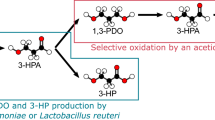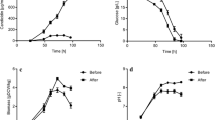Abstract
The production of cyclic adenosine monophosphate (cAMP) by Arthrobacter sp. A302 was studied in a 5 L stirred tank fermentor under a range of pH values (6.5–8.0) and glucose feeding rates. In batch fermentation under a controlled pH, the optimum pH for cell growth was 7.5 with dry cell density (X) of 11.43 g L, and the optimum pH for cAMP accumulation was 7.0 with cAMP concentration of 7.41 g L. In order to achieve the high X and cAMP yield simultaneously, a pH-shift control strategy was proposed based on kinetic analysis of specific cell growth rate (μ) and specific cAMP formation rate (q s ). In this method, pH was controlled to 7.0 for the first 30 h of fermentation, and then subsequently shifted to 7.5 and maintained until the end of the process. Application of this approach significantly enhanced the cAMP concentration. Thereafter, cAMP production was further improved by combining the above-mentioned pH-control system and fed-batch process with glucose at a constant feeding rate of 1.0 g L−1 h−1. Under optimum conditions, the final cAMP production was 10.87 g L, which is 110.0, 46.7, and 27.7% higher than that of the pH-uncontrolled, pH-controlled, and pH-shift controlled methods, respectively.






Similar content being viewed by others
References
Ando S, Kametani H, Osada H, Iwamoto M, Kimura N (1987) Delayed memory dysfunction by transient hypoxia and its prevention by forskolin. Brain Res 405:371–374
Brown DE, McAvoy A (1990) A pH controlled fed–batch process for dextransucrase production. J Chem Tech Biotechnol 48:405–414
Calik P, Bilir E, Calik G, Ozdamar TH (2003) Bioreactor operation parameters as tools for metabolic regulations in fermentation processes: influence of pH conditions. Chem Eng Sci 58:759–766
Chen XC, Bai JX, Cao JM, Li ZJ, Xiong J, Zhang L, Hong Y, Ying HJ (2009) Medium optimization for the production of cyclic adenosine 3′, 5′–monophosphate by Microbacterium sp. no.205 using response surface methodology. Bioresour Technol 100:919–924
Chen XC, Song H, Fang T, Bai JX, Xiong J, Ouyang PK, Ying HJ (2010) Enhanced cyclic adenosine monophosphate production by Arthrobacter A302 through rational redistribution of metabolic flux. Bioresour Technol 101:3159–3163
Choi SU, Paik HD, Lee SC, Nihira T, Hwang YI (2004) Enhanced productivity of human lysozyme by pH-controlled batch fermentation of recombinant Saccharomyces cerevisiae. J Biosci Bioeng 98:132–135
Feng XH, Xu H, Yao J, Li S, Zhu HY, Ouyang PK (2010) Kinetic analysis and pH–shift control strategy for propionic Acid production with Propionibacterium Freudenreichii CCTCC M207015. Appl Biochem Biotechnol 160:343–349
Fu WQ, Lin JP, Cen PL (2008) Enhancement of 5–aminolevulinate production with recombinant Escherichia coli using batch and fed–batch culture system. Bioresour Technol 99:4864–4870
Hong D, Peng XR (2003) Role of the cAMP in immunological liver injury in mice: comparing LPS–induced model with LPS + BCG-indudced model. Chin Pharmacol Bull 19:940–943
Hu ZC, Zheng YG, Wang Z, Shen YC (2006) pH control strategy in astaxanthin fermentation bioprocess by Xanthophyllomyces dendrorhous. Enzyme Microb Technol 39(4):586–590
Ishiyama J (1981) Effects of metal ions on cyclic AMP production by Microbacterium sp. no. 205. Nihon Nogekagaku 55:777–785
Ishiyama J (1990) Isolation of mutants with improved production of cAMP from Microbacterium sp. no. 205 (ATCC21376). Appl Microbiol Biotechnol 34:359–363
Ishiyama J, Kato M, Yoshida F and Yokotsuka T (1977) Process for producting 3’, 5’-cyclic adenylic acid. US Patent 4028184
Kleman GL, Strohl WR (1994) Aectate metabolish by Escherichiacoli in high-cell-density fermentation. Appl Environ Microbiol 60:3952–3958
Lishnevskaia EB, Kuzina ZA, Asinovskaia NK, Belousova II, Malkov MA (1986) Cyclic adenosine-3’, 5-monophosphate in Streptomyces antibioticus and its possible role in regulating oleandomycin biosynthesis and the growth of the culture. Mikrobiologiia 55(3):455–460
Liu YP, Zheng P, Sun ZH, Ni Y, Dong JJ, Wei P (2008) Strategies of pH control and glucose–fed batch fermentation for production of succinic acid by Actinobacillus succinogenes CGMCC1593. J Chem Technol Biotechnol 83:722–729
Moutinho A, Hussey PJ, Trewavas AJ, Malhó R (2001) cAMP acts as a second messenger in pollen tube growth and reorientation. Proc Natl Acad Sci 98:10481–10486
Oguma T, Honma S, Kijima T (1990) Dipeptides as the smallest proteinaceous activators of dephosphorylation of inosinic acid to inosine in 3’, 5’–cyclic AMP fermentation by Microbacterium sp. Agric Biol Chem 54:2721–2722
Okabayashi T, Yoshimoto A, Ide M (1963) Occurrence of nucleotides in culture fluids of microorganisms. J Bacteriol 86:930–936
Rall TW, Sutherland EW, Berthet J (1957) The relationship of epinephrine and glucagon to liver phosphorylase. IV. Effect of epinephrine and glucagon on the reactivation of phosphorylase in liver homogenates. J Biol Chem 224:463–475
Rodrigues DCGD, Da Silva SS, Vitolo M (2002) Influence of pH on the xylose reductase activity of Candida guilliermondii during fed-batch xylitol bioproduction. J Basic Microbiol 42:201–206
Samuelov NS, Lamed R, Lowe S, Zeikus JG (1991) Influence of CO2–HCO3 levels and pH on growth, succinate production, and enzyme activities of Anaerobiospirillum succiniciproducens. Appl Environ Microbiol 57:3013–3019
Santiago-Gomez MP, Thanh HT, De Coninck J, Cachon R, Kermasha S, Belin JM, Gervais P, Husson F (2009) Modeling hexanal production in oxido-reducing conditions by the yeast Yarrowia lipolytica. Process Biochem 44(9):1013–1018
Song H, Chen XC, Cao JM, Fang T, Bai JX, Xiong J, Ying HJ (2010) Directed breeding of an Arthrobacter mutant for high-yield production of cyclic adenosine monophosphate by N + ion implantation. Radiat Phys chem 79:826–830
Sutherland EW, Rall TW (1957) The properties of an adenine ribonucleotide produced with celluar particles, ATP, Mg2+ and epinephrine or glucagons. J Am Chem Soc 799:3608–3613
Tang IC, Okos MR, Yang ST (1989) Effects of pH and acetic acid on homoacetic fermentation of lactate by Clostridium formicoaceticum. Biotechnol Bioeng 34:1063–1074
Tsai SF, Yang C, Wang SC, Wang JS, Hwang JS, Ho SP (2004) Effect of thuringiensin on adenylate cyclase in rat cerebral cortex. Toxicol Appl Pharm 194:34–40
Weuster-Botz D, Altenbach-Rehm J, Arnold M (2001) Parallel substrate feeding and pH control in shaking flasks. Biochem Eng J 7:163–170
Wu Q, Xu H, Ying HJ, Ouyang PK (2010) Kinetic analysis and pH-shift control strategy for poly (gamma-glutamic acid) production with Bacillus subtilis CGMCC 0833. Biochem Eng J 50:24–28
Zhou JW, Chang YF, Xu ZH (2007) Production of thuringiensin by fed-batch culture of Bacillus thuringiensis subsp. Darmstadiensis 032 with an improved pH-control glucose feeding strategy. Process Biochem 42:52–56
Acknowledgments
This work was supported by the Major Basic R & D Program of China (2009CB724700), China National Funds for Distinguished Young Scientists (21025625) and a Project Funded by the Priority Academic Program Development of Jiangsu Higher Education Institutions.
Author information
Authors and Affiliations
Corresponding author
Additional information
Jiaming Cao and Xiaochun Chen have equally contributed to this study.
Rights and permissions
About this article
Cite this article
Cao, J., Chen, X., Ren, H. et al. Production of cyclic adenosine monophosphate by Arthrobacter sp. A302 using fed-batch fermentation with pH-shift control. World J Microbiol Biotechnol 28, 121–127 (2012). https://doi.org/10.1007/s11274-011-0799-y
Received:
Accepted:
Published:
Issue Date:
DOI: https://doi.org/10.1007/s11274-011-0799-y




